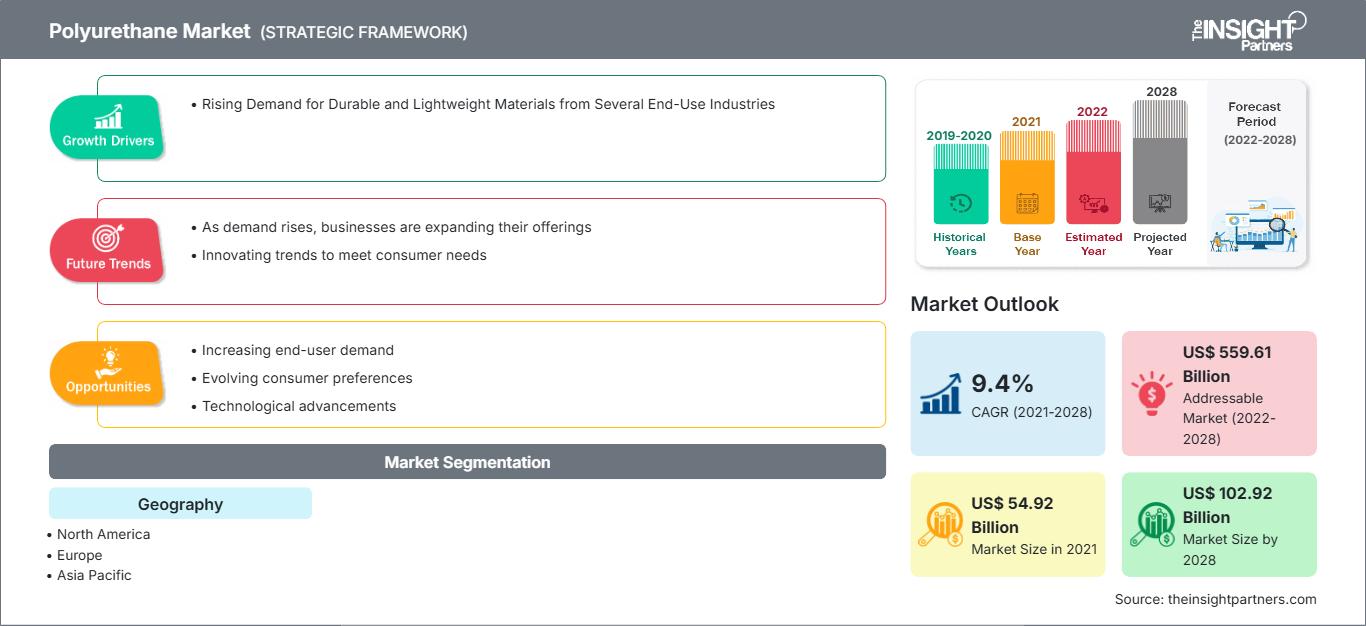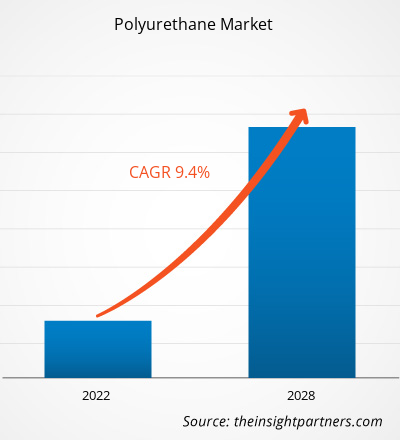[Rapporto di ricerca] Il mercato del poliuretano è stato valutato a 54.917,09 milioni di dollari nel 2021 e si prevede che raggiungerà 1.02.916,80 milioni di dollari entro il 2028; si prevede una crescita a un CAGR del 9,4% dal 2020 al 2028. ANALISI DI MERCATO
Il poliuretano è un materiale sintetizzato mediante copolimerizzazione di un isocianato e di un alcol polivalente. I compositi e le miscele di poliuretano trovano ampie applicazioni nell'elettronica e nell'optoelettronica. Gli utilizzi del poliuretano sono ampi e includono sensori, elettroliti, attuatori, schermatura EMI per supercondensatori e batterie, dissipazione elettrostatica e applicazioni a memoria di forma. Il mercato potenziale per l'elettronica stampata è enorme. Il PU e i suoi adesivi compositi hanno trovato applicazione nell'elettronica flessibile e stampata. I composti poliuretanici per l'incapsulamento sono specificamente formulati dagli sviluppatori per soddisfare una vasta gamma di proprietà fisiche, termiche ed elettriche. Possono proteggere i dispositivi elettronici offrendo eccellenti proprietà isolanti e adesive, un'eccezionale schiuma flessibile, resistenza all'acqua e alle temperature.
MOTORI DI CRESCITA E SFIDE
Il crescente sostegno governativo allo sviluppo delle infrastrutture e il crescente utilizzo del poliuretano come materiale isolante in tutto il mondo hanno favorito la crescita del mercato dei prodotti industriali in poliuretano. I governi di diversi paesi in tutto il mondo si stanno concentrando sullo sviluppo infrastrutturale nazionale. Il progresso infrastrutturale comprende progetti relativi a strade, porti, ferrovie e aeroporti; progetti in agricoltura ed energie rinnovabili; e infrastrutture industriali e sociali. Secondo TATA Capital, il Bilancio 2020 ha anche dato impulso allo sviluppo infrastrutturale per incoraggiare la spesa in progetti infrastrutturali per strade, ferrovie, aeroporti, autostrade e porti. Con lo stanziamento di oltre 1,25 trilioni di dollari per progetti infrastrutturali, il governo indiano ha individuato oltre 6.500 progetti nell'ambito del National Infrastructure Pipeline (NIP) per costruire un'economia da 5 trilioni di dollari entro il 2025. Tali attività stanno sostenendo il settore delle costruzioni, principalmente nei paesi in via di sviluppo, e creerebbero ampie opportunità per il mercato del poliuretano nei prossimi anni. La volatilità dei prezzi delle materie prime utilizzate nella produzione del poliuretano rappresenta una sfida per il mercato del poliuretano. I produttori producono schiuma di poliuretano principalmente facendo reagire polioli e diisocianati, ed entrambi questi prodotti sono derivati dal petrolio greggio. Pertanto, la volatilità dei prezzi del petrolio greggio influisce sui costi di produzione del poliuretano. I prezzi internazionali del petrolio greggio hanno registrato un'incertezza nel 2020, che continua anche nel 2021. Sia la domanda che i prezzi del petrolio greggio sono diminuiti drasticamente nei primi mesi del 2020 a causa dei lockdown e delle restrizioni di viaggio in diversi paesi del mondo. Anche i prezzi del petrolio sono crollati a tal punto che il prezzo del greggio WTI e il benchmark del greggio statunitense sono diventati negativi nell'aprile 2020.
Personalizza questo rapporto in base alle tue esigenze
Potrai personalizzare gratuitamente qualsiasi rapporto, comprese parti di questo rapporto, o analisi a livello di paese, pacchetto dati Excel, oltre a usufruire di grandi offerte e sconti per start-up e università
Mercato del poliuretano: Approfondimenti strategici

-
Ottieni le principali tendenze chiave del mercato di questo rapporto.Questo campione GRATUITO includerà l'analisi dei dati, che vanno dalle tendenze di mercato alle stime e alle previsioni.
L'"Analisi del mercato globale del poliuretano fino al 2030" è uno studio specializzato e approfondito con particolare attenzione alle tendenze del mercato globale e alle opportunità di crescita. Il rapporto mira a fornire una panoramica del mercato globale con una segmentazione dettagliata per materia prima, prodotto, applicazione e area geografica. Il mercato globale del poliuretano ha registrato una forte crescita nel recente passato e si prevede che questa tendenza continuerà durante il periodo di previsione. Il rapporto fornisce statistiche chiave sul consumo di poliuretano a livello mondiale, insieme alla domanda nelle principali regioni e paesi. Inoltre, il rapporto fornisce una valutazione qualitativa di vari fattori che influenzano l'andamento del mercato del poliuretano nelle principali regioni e paesi. Il rapporto include anche un'analisi completa dei principali attori del mercato del poliuretano e dei loro principali sviluppi strategici. Sono incluse anche diverse analisi sulle dinamiche di mercato per aiutare a identificare i principali fattori trainanti, le tendenze di mercato e le opportunità redditizie che, a loro volta, aiuterebbero a identificare le principali fonti di reddito.
Inoltre, l'analisi dell'ecosistema e l'analisi delle cinque forze di Porter forniscono una visione a 360 gradi del mercato globale del poliuretano, che aiuta a comprendere l'intera catena di approvvigionamento e i vari fattori che influenzano la crescita del mercato.
ANALISI SEGMENTALE
Il mercato globale del poliuretano è segmentato in base a materia prima, prodotto e applicazione. In base alla materia prima, il mercato del poliuretano è segmentato in poliolo, MDI, TDI e altri. In base al prodotto, il mercato è classificato in schiuma rigida, schiuma flessibile, rivestimenti, adesivi, sigillanti e leganti, elastomeri e altri. Il mercato del poliuretano è classificato in base all'applicazione in arredamento e interni, edilizia, elettronica ed elettrodomestici, automotive, calzature, imballaggi e altri. In base alla materia prima, i polioli rappresentavano una quota significativa. I polioli sono composti organici con più gruppi ossidrilici. Sono tra le principali materie prime utilizzate nella produzione di poliuretani. Il metilendifenildiisocianato (MDI) è un composto aromatico utilizzato nella produzione di poliuretano. Viene fatto reagire con i polioli per formare poliuretano. Il toluenediisocianato (TDI) è un composto chimico che si presenta come un liquido trasparente, giallo pallido o incolore. Viene utilizzato per produrre schiume poliuretaniche flessibili, ampiamente utilizzate in applicazioni come letti e mobili, sottotappeti e materiali da imballaggio. Le materie prime utilizzate per la produzione di poliuretani, oltre a polioli e diisocianati, sono stabilizzanti e additivi. In base al prodotto, la schiuma flessibile rappresentava la quota di mercato più elevata. La schiuma poliuretanica flessibile è caratterizzata da una struttura cellulare che consente un certo grado di compressione e resilienza, che fornisce un effetto ammortizzante. Grazie a questa proprietà, è un materiale preferito per mobili, attrezzature sportive, imballaggi, calzature, biancheria da letto, sedili per automobili e cuscini per tappeti. Svolge inoltre un ruolo prezioso nell'isolamento acustico e nella filtrazione. La schiuma poliuretanica rigida è nota come uno dei materiali isolanti più efficienti e ad alte prestazioni; inoltre, consente un risparmio energetico molto efficace con un'occupazione minima di spazio.
ANALISI REGIONALE
Il rapporto fornisce una panoramica dettagliata del mercato globale del poliuretano in cinque regioni principali, ovvero Nord America, Europa, Asia-Pacifico (APAC), Medio Oriente e Africa (MEA) e America meridionale e centrale. L'Asia-Pacifico rappresentava una quota significativa del mercato, con un valore di oltre 9.500 milioni di dollari nel 2022. I paesi emergenti dell'Asia-Pacifico stanno assistendo a un'ulteriore impennata dell'urbanizzazione e dell'industrializzazione, che offre ampie opportunità per i principali attori del mercato del poliuretano. Paesi come Australia, Giappone, India, Cina, Corea del Sud, Singapore, Taiwan e Indonesia dispongono di grandi industrie manifatturiere in settori diversificati, tra cui quello chimico, tessile, automobilistico, elettronico e altri. Il settore manifatturiero in questi paesi ha subito un enorme cambiamento nel corso degli anni. Il Nord America ha raggiunto un valore di oltre 3.500 milioni di dollari nel 2022. Il mercato del poliuretano in questa regione è in crescita grazie alla crescente domanda da parte dei settori dell'arredamento e degli interni, dell'edilizia, dell'elettronica e degli elettrodomestici, dell'automotive, delle calzature, degli imballaggi e di altri settori situati in Nord America.
SVILUPPI DEL SETTORE E OPPORTUNITÀ FUTURE
Il rapporto fornisce una panoramica dettagliata del mercato globale del poliuretano in cinque regioni principali, ovvero Nord America, Europa, Asia-Pacifico (APAC), Medio Oriente e Africa (MEA) e America meridionale e centrale.
Nel 2021, Covestro ha completato con successo l'acquisizione del business Resins & Functional Materials da DSM.
Nel 2020, Huntsman Corporation ha annunciato di aver cambiato il marchio della sua attività leader mondiale nella produzione di schiume poliuretaniche a spruzzo (SPF) in Huntsman Building Solutions (HBS). HBS è una piattaforma globale all'interno della divisione Poliuretani di Huntsman.
Approfondimenti regionali sul mercato del poliuretano
Le tendenze regionali e i fattori che influenzano il mercato del poliuretano durante il periodo di previsione sono stati ampiamente spiegati dagli analisti di The Insight Partners. Questa sezione illustra anche i segmenti e la distribuzione geografica del mercato del poliuretano in Nord America, Europa, Asia-Pacifico, Medio Oriente e Africa, America Meridionale e Centrale.
Ambito del rapporto sul mercato del poliuretano
| Attributo del rapporto | Dettagli |
|---|---|
| Dimensioni del mercato in 2021 | US$ 54.92 Billion |
| Dimensioni del mercato per 2028 | US$ 102.92 Billion |
| CAGR globale (2021 - 2028) | 9.4% |
| Dati storici | 2019-2020 |
| Periodo di previsione | 2022-2028 |
| Segmenti coperti |
By Geografia
|
| Regioni e paesi coperti |
Nord America
|
| Leader di mercato e profili aziendali chiave |
|
Densità degli operatori del mercato del poliuretano: comprendere il suo impatto sulle dinamiche aziendali
Il mercato del poliuretano è in rapida crescita, trainato dalla crescente domanda da parte degli utenti finali, dovuta a fattori quali l'evoluzione delle preferenze dei consumatori, i progressi tecnologici e una maggiore consapevolezza dei vantaggi del prodotto. Con l'aumento della domanda, le aziende stanno ampliando la propria offerta, innovando per soddisfare le esigenze dei consumatori e sfruttando le tendenze emergenti, alimentando ulteriormente la crescita del mercato.

- Ottieni il Mercato del poliuretano Panoramica dei principali attori chiave
Il rapporto fornisce una panoramica dettagliata del mercato globale del poliuretano in cinque regioni principali, ovvero: Nord America, Europa, Asia-Pacifico (APAC), Medio Oriente e Africa (MEA) e America meridionale e centrale. Settori come l'edilizia, l'automotive, l'elettronica e l'arredamento sono stati i principali consumatori di poliuretano. Nel 2020, questi settori hanno dovuto rallentare le loro attività a causa delle interruzioni nella catena del valore causate dalla chiusura dei confini nazionali e internazionali. Inoltre, i lockdown imposti da diversi paesi hanno ostacolato la capacità delle industrie di mantenere i livelli di inventario nello stesso anno. La carenza di manodopera ha comportato il rallentamento delle operazioni di produzione e distribuzione del poliuretano. Inoltre, le restrizioni governative e altre precauzioni contro il COVID-19 hanno ridotto le capacità produttive degli stakeholder dell'ecosistema del poliuretano. Nel 2021, il mercato globale ha iniziato a riprendersi dalle perdite subite nel 2020, poiché i governi di diversi paesi hanno annunciato allentamenti delle restrizioni sociali. Inoltre, si prevede che i progetti di costruzione precedentemente rinviati riprenderanno, il che offrirà un'ulteriore opportunità agli operatori del mercato del poliuretano di tornare alla normalità. L'espansione delle capacità produttive nel settore chimico e dei materiali in diverse regioni del mondo ha portato a un aumento della domanda di poliuretano nel 2021.
PAESAGGIO COMPETITIVO E AZIENDE CHIAVE
Alcuni degli operatori chiave e dei principali produttori di poliuretano che operano nel mercato del poliuretano includono, tra gli altri, Covestro AG, FXI, Huntsman Corporation, Lubrizol Corporation, Mitsui Chemicals Inc, BASF SE, The Dow Chemical Company, DIC Corporation, Recticel NV e Tosoh Corporation.
- Analisi storica (2 anni), anno base, previsione (7 anni) con CAGR
- Analisi PEST e SWOT
- Valore/volume delle dimensioni del mercato - Globale, Regionale, Nazionale
- Industria e panorama competitivo
- Set di dati Excel
Report recenti
Testimonianze
Motivo dell'acquisto
- Processo decisionale informato
- Comprensione delle dinamiche di mercato
- Analisi competitiva
- Analisi dei clienti
- Previsioni di mercato
- Mitigazione del rischio
- Pianificazione strategica
- Giustificazione degli investimenti
- Identificazione dei mercati emergenti
- Miglioramento delle strategie di marketing
- Aumento dell'efficienza operativa
- Allineamento alle tendenze normative






















 Ottieni un campione gratuito per - Mercato del poliuretano
Ottieni un campione gratuito per - Mercato del poliuretano